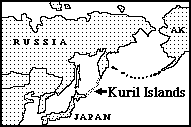
Spider Collector's Journal (8th page: Kuril 1997) © 2005 by Rod Crawford
As explained on the first page, most of these notes of fun (and not so fun) trips to collect spiders for research at the Burke Museum appeared in Scarabogram, newsletter of "Scarabs: The Bug Society," in their original forms. References to the editor mean me. Dates head each paragraph. Color Russian topographic maps have a black square 4 km grid for scale; contour interval is 40 m. RETURN TO INDEX
Just Another Summer in the Kuril Islands
 |
If you're not reading these pages in order, you may not know I had been involved since 1994 in an ambitious program to survey the flora and fauna of the Kuril Islands, newly accessible since the end of the Cold War (we were the first official American visitors since before World War II, and the first American scientists there ever). The project included plants, insects, fish, mollusks, spiders (that's me; I also did harvestmen and centipedes) and, in some years, various other groups. I will forestall your next question with the diagram at right. The archipelago is part of Russia, though the southernmost islands are claimed by Japan. There are 32 "major" islands in the group, of which the IKIP crew had landed on 27 to date. This year, our goal was to concentrate on the 4 northernmost islands of the chain: Shumshu, Paramushir, Atlasova (Alaid), and Makanrushi. See the separate pages on the 1994 and 1996 expeditions. If my narrative seems to harp on negative aspects, it's only that those are the most interesting parts; I did have a good time. All thanks to Professor Ted Pietsch for organizing and obtaining funding for the International Kuril Islands Project (IKIP), and to the National Science Foundation for funding it!
20 VII 1997: The American team this year included Ted Pietsch, Brian Urbain, Noboru Minakawa, Tim Pearce, Sarah Gage, Birgit Semsrott, and me from previous years; new were entomology student Todd Ritchie, fish student Duane Stevenson, and carabid beetle specialist Jere Schweikert of the California Academy of Sciences. We left Seattle practically on time...but without snail man Tim, who (as he discovered that morning) left his passport in Delaware! Would he be able to join us in Severo-Kurilsk? Only time would tell! We were again on an Aeroflot flight, which passed without incident.
21 VII 1997: Arrival virtually on time in Vladivostok, weather muggy as usual; back on board the good ship Professor Bogorov. There was no Russian spider man along this year; instead, added to the Russian team of previous years (Yuri, Larisa, Elyena and Valentina) were a mammalogist and two entomologists: Arkady Lelej, hymenopterist, and Sergei Storozhenko, orthopterist, my roommates on the ship. All under the leadership of malacologist Viktor Bogatov, with his notorious fondness for collecting at near-sea-level "Bogatov lakes." Yet another lovely Russian lady, Viktor's assistant Valentina Kalesnikova, came along this year. The team of five from Japan this time included my colleague Hozumi Tanaka, wolf spider specialist. 22 VII: Bureaucracy rears its head. Our "seaman cards" which we took much trouble to get, may or may not qualify us to sail. Our health forms were "Greek" to the Russian health inspectors. There was a new, previously unknown port tax. We didn't sail...and couldn't even shop because our passports were taken before the banks opened to change money. We watched bug-eyed as an entire hold of our ship was loaded with truckloads of vodka! 23 VII: At 4:00 AM, Viktor rousted us from bed so two stone-faced functionaries could compare our faces with our passports. No apology for such tactics! A sailor was heard to mutter "kommunista" in a most contemptuous tone. Then we promptly escaped from port, doubtless part of some Higher Strategy of our malacological Machiavelli. At least we were moving. We sailed through haze, almost fog, all day, and couldn't see a thing.
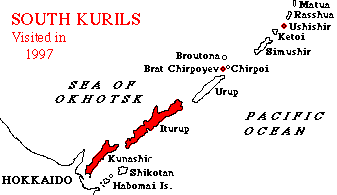 |
25-7 VII 1997: After 2.5 days at sea, going through La Perouse Strait and Yekateriny Strait (much longer than through Japanese waters, especially at 11 knots) amid haze and mist, we arrived at the southernmost island Kunashir about 5 hours later than announced, supposedly to "briefly check in" before heading for the northern islands. But we stayed 3 full days...and for 2 of those a privileged few headed for the hot springs while the rest stewed on board, amid constant rumors of imminent departure for the island (maybe!). The info on who would actually go mysteriously appeared out of nowhere at the instant each boatload embarked... These conditions, with Jere and me moping in the lab, spawned the Limerick of the Expedition:
Two faunistic collectors of note
Crossed the ocean to sit on a boat.
When they asked to explore
The terrain on the shore,
They were told it was better to float.
28 VII 1997: Still at Kunashir. Finally, after conflicting "we won't"-"we will"-"short time"-"long time" rumors, most of us got to shore for a brief period of 4 hours. Land at last! Jere and I started to hike southwest from Yuzhno-Kurilsk at once before ordered not to. My goal: a tantalizing bog at the base of a bluff which, on each prior visit to this island, I've been driven past without stopping. We were within 15 minutes of this site when we were picked up by the 3 Russian entomologists in a truck they somehow rustled up. By insisting, I managed to be dropped off only 7 minutes walk past my site. 2 hours' collecting here yielded about 80 spiders, plus a bag of moss containing 52 more. Walking back, I was picked up within 15 minutes of the dock by the Russian entomologists and Jere...this time in a bus! After a week of enforced inactivity, collecting and vigorous exercise felt great! Among my finds was Nispa barbatus, recently described from these islands by my colleague Kirill Eskov. Plenty of Toxicodendron lurked in the woods but I managed to avoid contacting any.
29 VII 1997: Finally headed north! Another unscheduled stop, at Kitovyi on the west side of Iturup island, explained the vodka in the hold: the Russian Academy of Science, strapped for money, was using its ships to carry cash cargo. All vodka was unloaded here. After many delays, the entire expedition arrived at noon for a half-day of collecting in a not-half-bad locality, a forested lowland stream valley with an abandoned fish hatchery. The woods proved to be full of Toxicodendron, the local "super-poison-ivy," but collecting along edges was productive, and all Americans contributed to a spider specimen total of 897. I found a Trochosa wolf spider with an ichneumonid parasitoid which Brian tried to rear out (it matured, ate the spider, and pupated, but never emerged).
30-31 VII 1997: A little farther up Iturup, we filled the ship's water tanks (an annual event) at the waterfall in Konservnaya Bay, where I spent several days collecting in previous years. The first afternoon, I hiked out onto the north headland. Collecting was only fair, but a nice spot except for finding the only patch of Toxicodendron in the area (!). On my way back to the ship, I went down too soon and had to struggle up two steep slopes covered with dense bamboo thickets. Great exercise, giving a whole new meaning to the term 'bamboo curtain'! A nice warm night for moth collecting, but more good moths came to the fluorescents in the onboard labs than to the UV light traps. On shore, Brian got a male Cheiracanthium japonicum - first medically important spider for the Kuril Islands! Next day, we finally left Iturup in late afternoon, now heading for Ushishir Islands, not on our original schedule for this year at all. You see, there was a Korean TV crew on board (more money for the Academy coffers) who wanted footage of "wildlife" by which they meant large mammals and flocks of birds.
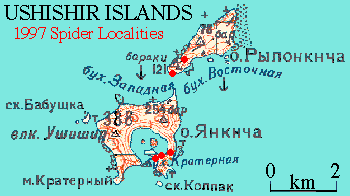 |
1-2 VIII 1997: After a chilly morning, my first sight of Ushishir through the finally lifting fog. Ushishir sure had flocks of birds...boat pilot Valera steered the landing craft right through a huge one! Though well collected for spiders in 1995, Yankicha (southern island of this little group) is certainly scenic (see photo, IKIP home page). The little boat headed through a breach in the wall of a half-submerged volcano right into "Crater Bay" whose waters are thermal, with hot springs along the shoreline. Not a tree or shrub on the whole island, which at times is exceedingly windy, but steep crater slopes covered with endless tall grass. 5 hours' collecting yielded 290 spiders, with 3 or 4 species new to the island. Next day: the Koreans wanted to "shoot" more birds, so the expedition crew headed for the smaller island of Ryponkicha, not visited in previous years. After a 5-minute delay, I arrived on deck to see the boat disappearing into the mist! Rats!! No second boat, and nobody would say why. Anyway, I got laundry done. Remarkably, all washing machines worked. Most of those lucky enough to get ashore on Ryponkicha didn't climb enough to get out of the same grassy habitat found on Yankicha. Duane Stevenson, only zoologist to reach the tundra-like plateau, found the best spider, a species originally described from Kamchatka in the 1920s. In all, 119 spiders were brought back. Ted says he didn't realize I wasn't on the boat!
3 VIII 1997: Well, here we were at Lovushki ('The Traps') Rocks, fit only for seals, last stop before proceeding to the northern islands we came to work on. We had the Korean wildlife photographers to thank for the further delay. Brian estimated there would now be only 15 days for actual work in the North Kurils, this year's ostensible goal. Four rocks were (initially) visible from the ship, 2 with some vegetation, then fog hid them. Last year aggressive seals prevented any landing here. This year (besides the Korean TV crew) one scientist each from Russia, Japan and USA attempted landing...with surprisingly little trouble. Duane, our sacrificial lamb, brought back a big bag of grass litter and smelly old seabird nests (mainly the latter), yielding 4 spider specimens (Leptorhoptrum robustum), proof that spiders can exist in places where a human would find residence impossible. The sample also contained Collembola, mites, fly larvae, oligochaetes, a new species of large brachypterous fly, and several beetle species. Duane found 3 plant species with not more than half of Dolgaya Rock vegetated.
 |
| Severo-Kurilsk area, Paramushir with '97 sites |
4 VIII 1997: We reached Severo-Kurilsk, island of Paramushir, on time, for a wonder. More amazing still, Tim was there! When we left him stranded in Seattle, I had suggested that after his passport arrived, he could fly to Kamchatka and catch a boat to Severo-Kurilsk. My Russian friend Yuri Marusik had done the same last year. At first, prospects for Tim's repeating the feat looked slim, but, as today proved, he actually did it! (By helicopter rather than boat, this time) and has been collecting on Paramushir every day, lucky dog, while we frittered our time away on birds and seals. On this first day on Paramushir, our main goal for 1997, much time was wasted transporting us in a jam-packed army truck (which broke down at least once each mile) to and from a boring coastal lake where we had 2.5 hours to collect, entirely in coastal meadow habitat. The 260 arachnid specimens did, however, include one spider and one harvestman species new to the island.
5 VIII 1997: Due to Tim's advance scouting of roads and trails, we actually got to a site in the mountains (for only 4 hours), the only such in this year's trip, at 300-450 m on Ebeko Volcano (see map above). Alas, our good weather had been used up, and it misted and drizzled all day, soaking (but very gradually) without being really rain. Vegetation was too wet to sample; habitats included alder thicket litter, extremely dry (must have been the first rain in weeks) and stones around snow fields which yielded a few very interesting species (including Perro camtschadalica and the sole specimen of a new harvestman), of 237 specimens total. At the end of the day, my new disposable rain pants were ready to dispose of!
6 VIII 1997: A large "Bogatov lake" was intended to be our first ever landing on the large but low and boggy island of Shumshu. Windy conditions forced a change of landing place, but before we could get to the new site, the real storm unexpectedly hit, forcing the ship to run for cover to the lee side of the Kamchatka Peninsula. Amid real stormy seas, our poor botanist and a few others got deathly seasick; I fortunately escaped thanks to a wonder drug nicknamed "Coast Guard cocktail." Somehow, the engine of the large landing boat got water damaged. Fortunately for them, the Koreans stayed behind on Paramushir to look for bears. So we had to use up the good weather sightseeing with that TV team, eh? Let the bears have them! Next day, the sun was out, and we were back at Shumshu for another try. But waves were high, we only had the little rubber speedboat, and enough non-Russians chickened out so that only Russians got to shore; yrs truly in a foul mood all day.
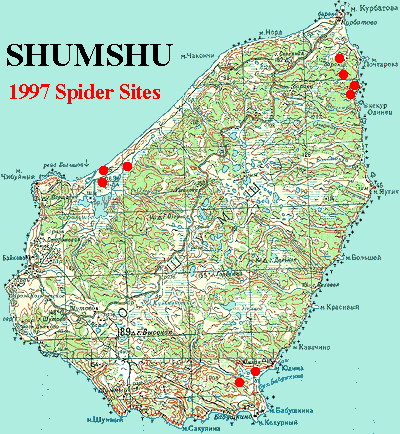 |
8 VIII 1997: Shumshu at last! Same landing place as yesterday, near the NE (drier) corner of the island, bad news for my original spider collecting plans due to a lack of Sphagnum bogs. Hiking inland and north, across a rolling meadow plain with low mixed-shrub thickets (alder, pine, heather, Rhododendron, Empetrum), I sampled a variety of only moderately productive habitats, for 166 specimens (others, sticking close to shore, got greater numbers). My most interesting site was an underground Japanese bunker from WWII with a few "cave" spiders.
9 VIII 1997: At the original planned first landing place on Shumshu, we finally had a full day of spider collecting in the North Kurils. Landing by an enormous lake ("Big Lake") and huge marsh meadow in NW Shumshu, much to my surprise there was no Sphagnum bog habitat. Nonetheless, between meadow, marsh, and thickets of alder and pine in foothills reached after a goodly hike, I got the first really decent spider sample from this island, including a species I'd been looking for through the entire project, plus the first known female of Poeciloneta dokutchaevi. Frustration lifted away. Typical North Kurils weather, gray and breezy. My new waders tested out well in crossing a deepish salmon stream, dodging upstream-bound fish.
10 VIII 1997: Our last day on Shumshu, an island that deserved a month's work at least. We landed just as a rain squall stopped (leaving all foliage sopping) at the Yuzhanka River on the SE tip of the island, an area of old vegetated dunes. Finding a grove of fairly tall alders in a stream ravine, I settled for sampling leaf litter most of the day, only moderately productive. Things finally dried out, though remaining dark and windy. Later, a few interesting larger spiders were found under objects on the dunes...where, crossing a level meadow, I walked right into a rusty metal spike protruding from the sand, puncturing my precious waders. The rolling dune scenery was very picturesque, despite heavy overcast. Fortunately, the big landing boat was fixed, because more big waves had come upon us during the day. Mischa Shubin, our highly-skilled boat pilot, steered us safely back to the ship through towering waves in an almost too-exciting farewell to Shumshu.
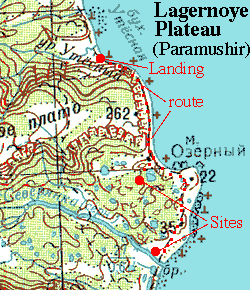 |
11 VIII 1997: Only 6 days were left for Paramushir, the most mountainous, large, and varied of the North Kurils. So, despite all announced plans, we landed at one of the 2 sites already sampled last year! Not ready to submit to nonsense, Duane Stevenson, Todd Ritchie and I hiked 4-6 km down the coast, much farther as the foot slogs, on a trail either so overgrown you couldn't see your feet or over rolling beach cobbles. In my case, the hike was amply rewarded by a beautiful sunny day (with rainbows) in rolling old-dune land and a lovely little Sphagnum bog, so isolated and silent I could hear the wingbeats of gulls flapping over me. Also some excellent spiders, including the bizarre little Savignya birostrum, originally described from Alaska! We returned to the boat on time, to find that the others had been recalled early. The emergency whistle from the ship sounded when we were already on the trail. Ah, the advantages of being beyond radio range. There was no official explanation of the "emergency" but rumor had it that Bogatov was invited to a party with local bigwigs! One of the nicest days of the trip, for me. Duane's turn to be frustrated: part of his expensive fishing rod fell out somewhere along the overgrown trail. They had gone all the way to the Severyanka River and seen lots of salmon.
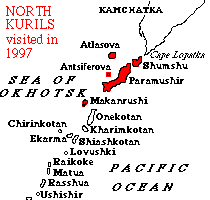 |
12 VIII 1997: Our first and (to date) only day on Atlasova, most northerly Kuril island, which consists of one huge, intermittently active volcano. On this isolated spot is found an endemic flower (the Alaid Poppy) and a spider known only from its original, Japanese description in 1932. Would I find it? Had a nice day for it, anyway, fairly easy to move around if one avoids the alder shrub thickets (nearly impossible otherwise). I personally collected 350 spiders (the entire group got over 600) but if the elusive Theridion araitense was there, I didn't recognize it. [But wait! Later research revealed that a rare linyphiid described in 1861 but only rediscovered recently, surprisingly common on Atlasova, was the same species.] Near our landing site: the ruins (and boy, are they ruined! not a wall standing!) of an extensive fishing village and military base abandoned 30-40 years ago. I was upbraided that morning for my "late" return yesterday, but secure in my innocence, I considered it a badge of honor. Today, it was somebody else's turn to get into trouble. Larisa, the lovely Russian malacologist, had set off with the speedboat pilot to circumnavigate the island with her video camera... little suspecting that it's 30 or 40 km in circumference! The boat gave out and they had to be towed back. Postscript to Atlasova: we learned later that the volcano is suspected to have erupted on August 23, when satellite imagery detected a hot spot and ash fell on nearby parts of Kamchatka. On the other hand, a fishing boat only 10 km from the island noticed nothing, so perhaps we'll never really know. Had we but been there 11 days later...
13 VIII 1997: Now only 5 days were left for Paramushir, the most mountainous, large, and varied of the North Kurils. The 13th, our first on the east side of the island, was only a half day, for that evening we had to go pick up that Korean TV crew, who had been out of our hair for several days, looking for bears. Warned to expect a wet landing, we all had our waders on...then the boat pulled up to a dock near Shelekhovo village. With no time to get far, I followed an overgrown road through head-high herbage of Filipendula, Sorbus and alder to a hilltop, where a stovepipe sticking out of a soil bank led me to an underground, two-room "house" connected by a trench system to storerooms and a latrine. Nobody lives there but spiders now. For the first time I reached someone on my radio: Brian on the next hill. Day's catch, 244 spiders.
 |
| Krasheninnikova Bay with '97 spider sites |
14 VIII 1997: Nobody lives at polysyllabic Krasheninnikova Bay, which was much more scenic despite morning fog. Two large rivers were here, a meandering low one and the rushing Alyenushkina which had the feel of a mountain stream. Hiking up the beach to ascend the latter, I had an enjoyable day, turning rocks and sifting the litter of tall, streamside alders, getting some of the most interesting species on the island. On a nearby hill, I had a "field day" among the ground webs (mainly of Bolyphantes alticeps but with some others), which the fog had made dewy and conspicuous, and also got a unique wolf spider. I found no Sphagnum until on the way back to the ship, when amazingly a well-developed bog turned up on the beach meadow terrace. One plastic bag of this moss yielded 61 spiders (also including some cool species) back on the ship. As we returned the fog lifted, revealing a chain of magnificent mountain peaks, the Karpinski Range, several 1400-1800 m in elevation, in whose very laps we had unknowingly spent our day. From the sea to 1816 m (5958 ft.) in 5 km! Climbing boots, anyone?
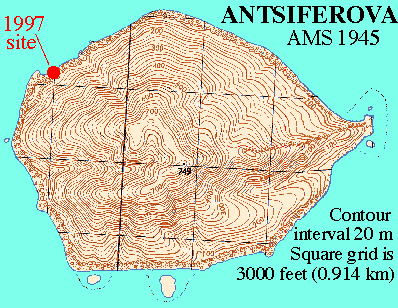 |
15 VIII 1997: In the morning, with fog even thicker than yesterday, we paid a brief visit to the shore of small, steep Antsiferova Island, not even shown on our maps. Wow, an uncharted island! But it's strictly for the birds (puffins, in part). We all left speckled. A nice, eerie effect as the shoreline suddenly loomed up before our boat out of a smooth, greasy seaweed-strewn sea. Supposedly we were the first scientists of any kind to visit this island, which yielded 171 specimens of 11 arachnid species, mainly from the base and lower 50 feet of cliffs and steep slopes. The long-jawed harvestman Nipponopsalis was surprisingly common under the seashore rock rubble, where it must be wetted by storm waves sometimes. One of the spiders appears to be new. The botanists got the most species (18); Arkady got just one ant and one fly species. As I found later from the map at right, we could have had access to the interior at the opposite end of the island, but no one knew that at the time.
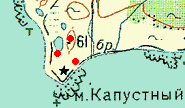 |
|
Cape Kapustnyi '97 sites |
This afternoon was our last visit to the west side of Paramushir, at Cape Kapustnyi where extensive shallows kept the large boat well offshore, the regular landing craft had engine trouble, and we had to be ferried ashore 2 at a time in a tiny rubber dinghy. Arriving on the beach at 4 PM, we found it to be another grassy dune peninsula, this one with a lighthouse but extremely poor in spiders. However, I did manage to collect a "cuckoo bumblebee," Psithyrus sp., new to the island list. On the very summit of this peninsula, a rocky knob sticks up out of the sand, and here a few interesting spiders were taken, as well as some alpine-looking plants pleasing to the botanists who had stayed behind.
16 VIII 1997: Last year we visited two sites on Paramushir. This year had already seen a repeat landing at one of them; now, of all the new sites we could have sampled, here we were at the other old one! Clearly, research value to most participants played little part in site choice. Oh well, another nice long hike would be good. For 5 km I hiked up the shore of the duny Vasil'yeva Peninsula (see map, previous page), through an army post (the soldiers looked bemused at my gear, but responded to "Dobroi den'" in friendly fashion), and into the hinterlands to a lovely spot on the banks of the Bol'shaya River. Many habitats were available here, but only moderately productive - perhaps too close to the sea. However, I did get there my only specimens of the tiny Phattothrata parva and a new species of Masikia. On the way back, I stopped off in the flats at the head of the peninsula, for worse luck. Nice and tired at the end of the day, I chalked this one up to exercise.
17 VIII 1997: Our last day on Paramushir was spent at Cape Baklanii in a southern part of the island that was new to us. Because of heavy swell and breakdown of the ship's crane, only the smaller boat was used. Despite a slow landing and only 5.5 hours to collect, a beautiful day provided excellent collecting on a ridge crest extending back from the cape, reached by a 15 minute walk on a very good bear trail. Several very productive habitats (including litter, pine shrub foliage, and the boards of a demolished shack) yielded about 450 specimens. At night, the ship returned to the Vasil'yeva peninsula so the fish people could try for a phantom "minnow" Brian saw in a lake.
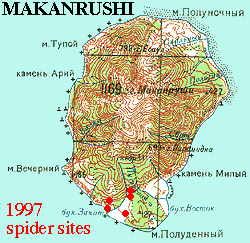 |
18 VIII 1997: Our first (and, to date, only) day on the mid-sized island of Makanrushi almost had to be aborted due to surf. Fortunately, the boat pilots found one spot where we could land without drowning by traversing a flat of slick seaweedy boulders. The island proved well worth the trouble. At the south end were extensive grassy flats; the north and central parts were taken up by a high, irregular volcano, and in between was a "foothill" area with lovely, varied topography. The flats yielding very little (other than a view of impressive monster surf on the Pacific side), I collected in a protected area of alders which proved to be the first "forest" (higher than my head) seen on the northern Kurils. Its litter fauna was not too diverse but included my sole specimen of Pelecopsis mengei. Then up to a "hanging valley" in the hills which had the best under-stone collecting on the trip. The flats were honeycombed with vole burrows, which rich food supply supports a large population of (red) Siberian foxes, the first I'd seen. In the hanging valley, I would periodically see one jump up to sneak a peek at me from its lurking place behind a ridge. And on this high note, we bid the north Kuril Islands farewell. Makanrushi is a fine island with lots of unsampled habitats, upland litter, pine...Todd even found a quaking bog on the Pacific side. Maybe some other time.
19 VIII 1997: Another Russian Academy research ship had to abandon gear at Ushishir during the big storm. Our ship stopped by to pick it up, as I labeled specimens.
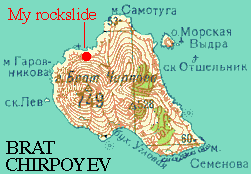 |
20 VIII 1997: The small island of Brat Chirpoyev in the central Kurils (an irregular section of the south rim of a giant volcanic caldera, largely submerged) had defied two previous attempts to land there; surprisingly, today it was easy, though on the steep side of the island. I made a beeline for a large rockslide (extending up from near the beach) visible from the ship, and took 52 specimens under stones. Climbing was easy but I noticed a few rocks were loose. On my way back down, just after steering to the right of a monster boulder that looked ill-supported, I stepped on the wrong rock, and the world started spinning. A few confusing seconds later, I found myself perhaps 8-10 m down the mountainside, up to my waist in boulders, and (as Noboru, who came to my rescue, pointed out) with a crushed left hand -- due to amazing luck, my only serious injury. He says bigger rocks just missed me. Fortunately, shock didn't set in until I was back in the ship's doctor's office; and it was the last day of collecting, so I didn't spoil the expedition!
21 VIII 1997: After sailing all night, we arrived at the large, populated island of Iturup. Here, a local ambulance bumped across a pasture (!) to the local army hospital, which evidently hadn't been painted since World War II. The x-ray facility was modern, however, and the resulting pictures prompted a decision to send me on to the district hospital on Sakhalin (which is to the Kuril Islands as Vancouver Island is to the San Juans). My sojourn would occupy a few days, and sweet Valentina K. was detailed to accompany me. Life could be worse! The day's adventures included a wild 4-wheel-drive ride 50-60 km down the length of Iturup (slightly larger than King County, Washington) over some of the worst roads ever felt by this bruised body (but with delightful company and Louis Armstrong on the tape deck!), at one point driving along the beach of the bay from which the Japanese attack on Pearl Harbor was launched, to the air base at Burevestnik, on the Pacific side of this island which I'd never seen before. Then into a large, ancient-looking prop-driven Russian Army cargo plane, where we sat on side benches (sans seat belts) facing an aisle piled high with huge canvas bags. The trip to Sakhalin was like riding inside a vibrator. On arrival, we were met by another ambulance, which took us over smooth paved roads through a variety of very pretty forest and field habitats, to the district hospital in Yuzhno-Sakhalinsk, the most pleasant and attractive town I'd yet visited in Russia. The doctors wore what looked like chef's hats. Before I knew it, I was out cold, having my finger bones set by the chief traumatologist. Elapsed time since the rockslide, about 26 hours. From the time I came to, a nurse (rather forbidding ones at first) gave me antibiotic injections every 3 hours.
22-3 VIII 1997: Valentina could only visit once a day, so I practiced my Russian on intern Sergei. Typical intern humor: that night, Sergei introduced me to the two prettiest nurses (Larisa and Galya) as my helpers for the shower! Alas, I had to learn to dress and shower single-handed. Next morning, cute young Galya took over injection duty, and my halting Russian continued to improve. The hospital was very quiet, very clean, if poorly supplied and equipped. One spider (Tegenaria domestica, amazingly the only record for Sakhalin) was collected in my hospital room.
24 VIII 1997: Checking out at noon, we had another 30 km ambulance ride to the seaport of Korsakov, where we were to meet our ship Professor Bogorov which, of course, was delayed. Valentina engaged a cheap waterfront hotel room, and from somewhere rounded up 2 guys with a door(!) to put under my hammock-like mattress. We wait. Dinner in a Korean restaurant (crab, spiced beef, rice, and Korean vegetables; Valentina rejected the borsch as not authentic), where a resident cat spent the meal in my lap; now, that's great service! Awakened at midnight -- the ship was here! After a speedboat ride across the dark waters of Korsakov harbor, "home" again.
After a few days packing and labeling specimens (7008 spiders and harvestmen for the expedition) and a day off to admire the beauties of Vladivostok, we took our regular flight back to Seattle, arriving Sunday of Labor Day weekend. On Tuesday, I saw my doctor, who referred me to a hand surgeon. As I type this [February 1998] (with both hands!), most of the remaining hardware has been out of my hand for about 12 days. Seven fractures in 4 fingers is no joke! In a phrase full of meaning to fellow Scarabs, I was very lucky not to be "squashed like a bug." Beware of unstable boulders!
This page last updated 21 March, 2025